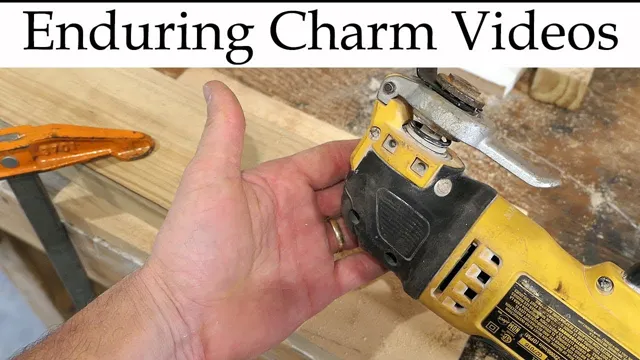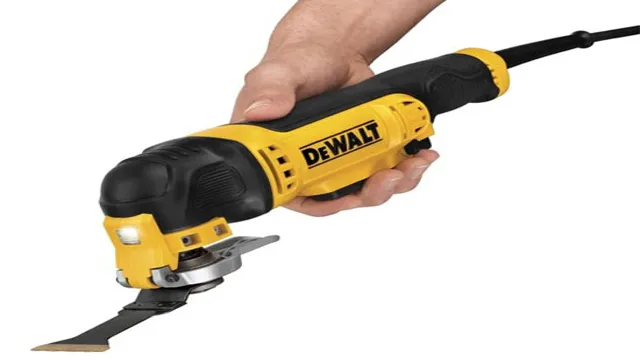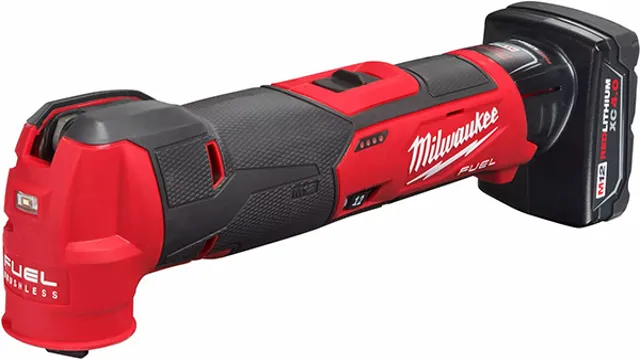How to Use an Oscillating Multi Tool for Effortless DIY Projects
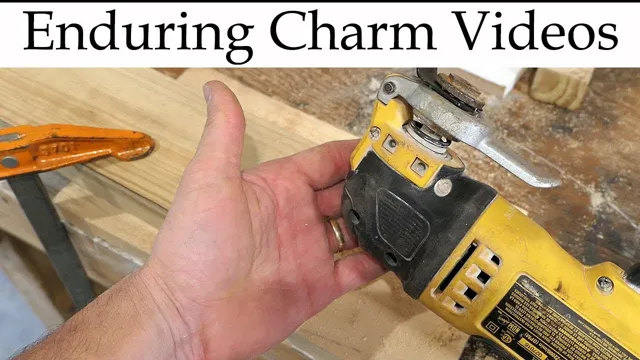
Have you ever heard of an oscillating multi-tool? Well, if you haven’t, it’s a versatile and efficient power tool that can help you tackle a wide range of DIY projects. This handy little tool is like having multiple power tools in one, thanks to its ability to accept a variety of attachments for different cutting, sanding, and grinding applications. But how do you use an oscillating multi-tool? Don’t worry; it’s easier than you might think, and today we’re going to walk you through the basics.
We’ll cover everything from selecting the right accessories to tips for getting the most out of this incredibly handy tool. So, whether you’re a DIY enthusiast or a professional contractor, read on to learn how to use an oscillating multi-tool like a pro.
What is an Oscillating Multi-Tool?
An oscillating multi-tool is a versatile tool used in a wide range of DIY and construction projects. It typically has a small, triangular head and a variety of attachments that can be swapped out quickly and easily. But, how to use an oscillating multi-tool? Firstly, you need to decide on the right attachment for your project.
There are a variety of attachments available, including sanding pads, saw blades, and grout removers. Once you have selected the correct attachment, simply attach it to the head of the tool and turn it on. These tools are particularly useful for small, intricate tasks that cannot be completed with larger tools.
They can do anything from sanding and grinding to sawing and cutting. Moreover, their versatility and ease of use make them essential for any DIY enthusiast or contractor. So, if you’re looking for a powerful and versatile tool, consider getting an oscillating multi-tool.
You won’t regret it!
Explanation of Tool and Parts
An oscillating multi-tool is a versatile power tool that can perform a wide range of tasks with a variety of interchangeable attachments. This handy tool is designed to oscillate back and forth at high speeds, providing quick and precise cutting, sanding, scraping, and grinding capabilities. The oscillating multi-tool is powered either by electricity or battery, depending on the model.
It is known for its compact size, making it easy to handle and maneuver in small spaces that larger tools cannot reach. With its ability to handle a variety of materials, including wood, metal, plastic, and even drywall, an oscillating multi-tool is an essential tool for any DIY enthusiast or professional contractor. Whether you need to cut door jambs, sand cabinets, or flush-cut baseboards, an oscillating multi-tool has got you covered.
So, if you’re looking for a tool that offers versatility, precision, and ease of use, an oscillating multi-tool is the right choice for you.
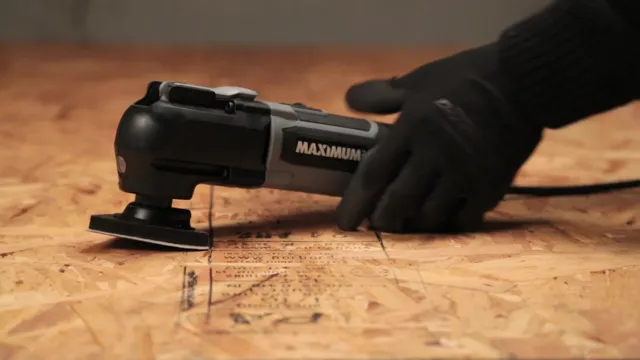
Safety Precautions to Take
An oscillating multi-tool is a versatile tool that can be used for various tasks like sanding, cutting, and scraping. It works by oscillating back and forth at high speeds, making it capable of handling a wide range of materials. However, it’s important to take some safety precautions when using an oscillating multi-tool.
Firstly, wear the necessary protective gear such as safety glasses, a face mask, and gloves to prevent injuries from flying debris or dust. Also, ensure the tool is unplugged or its battery removed before changing blades or accessories. Additionally, always read and follow the instructions provided in the manual carefully, and avoid forcing the tool to do something it’s not designed for.
Remember that the oscillating multi-tool blade gets very hot when in use, so never touch it immediately after use. By taking these precautions, you can ensure your safety and enjoy the convenience of using an oscillating multi-tool for various tasks.
Choosing the Right Blade
When it comes to using an oscillating multi-tool, choosing the right blade can make all the difference. There are a variety of blades available, each designed for specific tasks. For example, a plunge cut blade is ideal for making precise cuts in the middle of a material, while a flush cut blade is perfect for trimming materials flush to a surface.
It’s important to consider the material you’ll be working with as well, as different blades are better suited for cutting through wood, metal, or tile. Additionally, pay attention to the blade’s teeth per inch (TPI) as this can affect the speed and precision of your cuts. By choosing the right blade for your project, you’ll be able to efficiently and effectively tackle any task with your oscillating multi-tool.
Types of Blades and Their Uses
When it comes to choosing the right blade, there are a few things to consider, such as the type of material you’ll be cutting, the size of the job, and the type of saw you have. If you plan on cutting through thick materials like plywood or hardwood, you’ll want to go with a blade that has a higher tooth count. The more teeth a blade has, the smoother the cut will be.
On the other hand, if you’re working on a smaller project or need to make quick cuts, a blade with fewer teeth may be more appropriate. It’s also important to note that different types of saws require different types of blades. For example, a circular saw requires a blade that’s specifically designed for circular cutting, while a jigsaw requires a blade that can handle curved cuts.
Ultimately, understanding the type of blade you need for the specific job at hand will help you achieve the best possible results.
How to Attach and Detach the Blades Safely
When it comes to using a machine with multiple blades, it is crucial to select the appropriate blade for the job. Different blades are designed to cut different materials, so selecting the right blade can make all the difference in efficiency and safety. Before attaching the blade, it’s important to ensure that the machine is not plugged in and turned off.
Once you have the right blade, carefully attach it to the machine following the manufacturer’s instructions. Make sure it is properly secured before turning the machine on and using it. When it comes time to detach the blade, always do so with the machine turned off and unplugged to avoid any accidents.
Removing the blade carefully and storing it properly will help ensure the longevity of both the blade and the machine. Remember to always prioritize safety when attaching and detaching blades, and never compromise on using the correct tool for the job.
Performing Common Tasks with the Multi-Tool
If you’re interested in learning how to use an oscillating multi-tool, then you’re in the right place. This versatile power tool is ideal for tackling a wide range of tasks, from sanding and cutting to scraping and grinding. One common use for an oscillating multi-tool is removing old grout from between tiles, which can be a real pain using traditional tools.
With the multi-tool’s angled blade attachment, you can quickly and easily cut through the grout without damaging the tiles. Another task that an oscillating multi-tool excels at is trimming door jambs and other materials to make room for flooring, without having to remove the door or trim. By attaching a flush-cut blade, you can make precise cuts with ease.
The possibilities are endless with an oscillating multi-tool, and once you get the hang of using it, you’ll be amazed at how many jobs it can handle.
Removing Grout with the Multi-Tool
If you’ve ever attempted to remove grout manually, you know how frustrating and labor-intensive the process can be. But with a multi-tool, removing grout is a breeze. This versatile tool can scrape away even the toughest grout quickly and efficiently.
Whether you’re working on a DIY home project or a professional renovation, a multi-tool is a must-have. No longer will you have to spend countless hours scrubbing away at grout with a toothbrush or other manual scraping tools. With a multi-tool, the task is much easier and faster, allowing you to move on to other parts of your project in no time.
So, if you’re looking for a tool that can handle a variety of tasks, including removing grout, look no further than the multi-tool. It’s a game-changer!
Cutting Wood and Metal with the Multi-Tool
The multi-tool is an incredibly versatile tool that can perform many common tasks. One of the most useful features of a multi-tool is its ability to cut through wood and metal. With the right blade attachment, you can easily trim branches or cut through boards of varying sizes.
Not only that, but you can also use your multi-tool to slice through metal pipes, wires, and bolts. The ability to cut through both wood and metal makes the multi-tool an indispensable piece of equipment for those who work in construction or maintenance. Plus, with its compact size, it’s easy to carry with you wherever you go.
So, whether you’re working on a construction site or doing some DIY at home, the multi-tool has got you covered. So, don’t waste any time when you have a multi-tool in your toolbox.
Maintaining and Storing the Multi-Tool
If you want to know how to use an oscillating multi tool, it’s also worth noting how to properly store and maintain it. First and foremost, you want to ensure that the tool is clean and dry before putting it away. This will help prevent rust and corrosion from building up on the blade or any metal components.
Additionally, it’s a good idea to keep the tool in a dry, cool place, away from any moisture or extreme temperatures. When it comes to maintenance, make sure to periodically check the blade for any damage or wear. If you notice any problems, replace the blade immediately to prevent injury or damage to your workpiece.
You can also lubricate moving parts with a small amount of oil to keep the tool running smoothly and enhance its lifespan. By following these simple tips, you can keep your oscillating multi tool in optimal condition and use it for years to come.
Cleaning the Tool After Use
Maintaining and storing your multi-tool properly is essential to ensure it works effectively and lasts a long time. One vital step in this process is cleaning the tool after use. At first, remove the dirt and debris from the tool’s surface with a soft brush or cloth.
If there are stubborn materials stuck in the crevices, utilize a toothbrush and soapy water to scrub them away gently. Make use of a dry cloth to wipe the tool again before utilizing a lubricant on the moving parts. Lubrication extends the lifespan of the tool while also ensuring it functions effectively.
Proper maintenance and cleaning are especially important if you are using the tool in a damp or corrosive environment, as it can prevent rust and ensure the tool remains functional for years to come.
Storing the Tool Safely and Properly
Proper maintenance and storage of your multi-tool are just as important as using it effectively. After all, even the best multi-tool won’t last long if it’s not well-taken care of. One of the first things you can do to store your tool safely is to clean it after every use.
This means wiping it down with a clean cloth and removing any debris stuck in the nooks and crannies. You should also oil your tool’s moving parts from time to time to prevent rust and keep everything working smoothly. When storing your multi-tool, make sure it’s in a dry and secure place where it won’t get jostled around or damaged.
Keeping it in a sturdy case or sheath is an excellent way to prevent it from getting knocked around or lost. Additionally, it’s a good idea to periodically check the tool for any damage or wear and tear that could compromise its effectiveness. By following these simple tips, you can ensure that your multi-tool is always in top condition, ready for action when you need it.
Conclusion
In conclusion, using an oscillating multi tool is like having a superpower in your toolbox. With its ability to cut, sand, scrape, and more, you have the power to tackle any DIY or home improvement project like a pro. Just remember to use the right attachment for the job, wear protective gear, and handle the tool with care.
With these tips, you’ll be oscillating your way to success in no time. So go forth, DIY warriors, and make your projects a cut above the rest!”
FAQs
What are some common uses for an oscillating multi tool?
An oscillating multi tool can be used for cutting, sanding, grinding, scraping, and polishing a variety of materials including wood, metal, and plastic.
How do I attach different accessories to an oscillating multi tool?
Most oscillating multi tools require you to use a screwdriver or Allen wrench to attach and remove accessories.
Can I use an oscillating multi tool to cut through metal pipes?
Yes, an oscillating multi tool with a metal cutting blade can be used to cut through metal pipes.
How can I prevent my oscillating multi tool from overheating?
To prevent overheating, make sure to use the correct speed setting for the material you are working with and take frequent breaks.
How do I maintain my oscillating multi tool?
It is important to keep the tool clean and lubricated, and to regularly inspect the accessory attachment mechanism for wear and tear.
Can I use an oscillating multi tool in damp or wet conditions?
No, an oscillating multi tool should not be used in damp or wet conditions as it poses a risk of electrical shock.
What safety precautions should I take when using an oscillating multi tool?
Wear eye and ear protection, gloves, and a dust mask when appropriate, and make sure the tool is unplugged before changing accessories or making adjustments.

